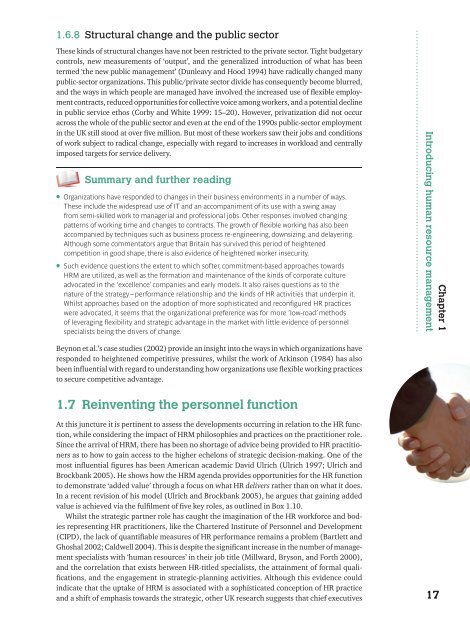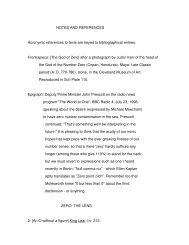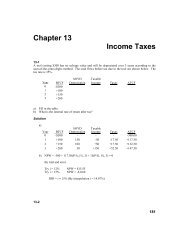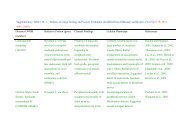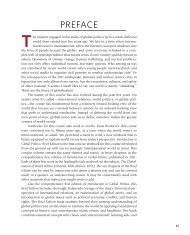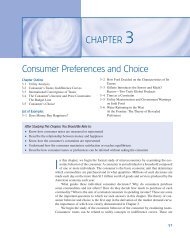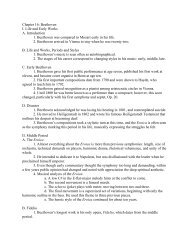Human Resource Management in Context
Human Resource Management in Context
Human Resource Management in Context
Create successful ePaper yourself
Turn your PDF publications into a flip-book with our unique Google optimized e-Paper software.
1.6.8 Structural change and the public sector<br />
These k<strong>in</strong>ds of structural changes have not been restricted to the private sector. Tight budgetary<br />
controls, new measurements of ‘output’, and the generalized <strong>in</strong>troduction of what has been<br />
termed ‘the new public management’ (Dunleavy and Hood 1994) have radically changed many<br />
public-sector organizations. This public/private sector divide has consequently become blurred,<br />
and the ways <strong>in</strong> which people are managed have <strong>in</strong>volved the <strong>in</strong>creased use of fl exible employment<br />
contracts, reduced opportunities for collective voice among workers, and a potential decl<strong>in</strong>e<br />
<strong>in</strong> public service ethos (Corby and White 1999: 15–20). However, privatization did not occur<br />
across the whole of the public sector and even at the end of the 1990s public-sector employment<br />
<strong>in</strong> the UK still stood at over fi ve million. But most of these workers saw their jobs and conditions<br />
of work subject to radical change, especially with regard to <strong>in</strong>creases <strong>in</strong> workload and centrally<br />
imposed targets for service delivery.<br />
Summary and further read<strong>in</strong>g<br />
• Organizations have responded to changes <strong>in</strong> their bus<strong>in</strong>ess environments <strong>in</strong> a number of ways.<br />
These <strong>in</strong>clude the widespread use of IT and an accompaniment of its use with a sw<strong>in</strong>g away<br />
from semi-skilled work to managerial and professional jobs. Other responses <strong>in</strong>volved chang<strong>in</strong>g<br />
patterns of work<strong>in</strong>g time and changes to contracts. The growth of fl exible work<strong>in</strong>g has also been<br />
accompanied by techniques such as bus<strong>in</strong>ess process re-eng<strong>in</strong>eer<strong>in</strong>g, downsiz<strong>in</strong>g, and delayer<strong>in</strong>g.<br />
Although some commentators argue that Brita<strong>in</strong> has survived this period of heightened<br />
competition <strong>in</strong> good shape, there is also evidence of heightened worker <strong>in</strong>security.<br />
• Such evidence questions the extent to which softer, commitment-based approaches towards<br />
HRM are utilized, as well as the formation and ma<strong>in</strong>tenance of the k<strong>in</strong>ds of corporate culture<br />
advocated <strong>in</strong> the ‘excellence’ companies and early models. It also raises questions as to the<br />
nature of the strategy–performance relationship and the k<strong>in</strong>ds of HR activities that underp<strong>in</strong> it.<br />
Whilst approaches based on the adoption of more sophisticated and reconfi gured HR practices<br />
were advocated, it seems that the organizational preference was for more ‘low-road’ methods<br />
of leverag<strong>in</strong>g fl exibility and strategic advantage <strong>in</strong> the market with little evidence of personnel<br />
specialists be<strong>in</strong>g the drivers of change.<br />
Beynon et al.’s case studies (2002) provide an <strong>in</strong>sight <strong>in</strong>to the ways <strong>in</strong> which organizations have<br />
responded to heightened competitive pressures, whilst the work of Atk<strong>in</strong>son (1984) has also<br />
been <strong>in</strong>fl uential with regard to understand<strong>in</strong>g how organizations use fl exible work<strong>in</strong>g practices<br />
to secure competitive advantage.<br />
1.7 Re<strong>in</strong>vent<strong>in</strong>g the personnel function<br />
At this juncture it is pert<strong>in</strong>ent to assess the developments occurr<strong>in</strong>g <strong>in</strong> relation to the HR function,<br />
while consider<strong>in</strong>g the impact of HRM philosophies and practices on the practitioner role.<br />
S<strong>in</strong>ce the arrival of HRM, there has been no shortage of advice be<strong>in</strong>g provided to HR practitioners<br />
as to how to ga<strong>in</strong> access to the higher echelons of strategic decision-mak<strong>in</strong>g. One of the<br />
most <strong>in</strong>fl uential fi gures has been American academic David Ulrich (Ulrich 1997; Ulrich and<br />
Brockbank 2005). He shows how the HRM agenda provides opportunities for the HR function<br />
to demonstrate ‘added value’ through a focus on what HR delivers rather than on what it does.<br />
In a recent revision of his model (Ulrich and Brockbank 2005), he argues that ga<strong>in</strong><strong>in</strong>g added<br />
value is achieved via the fulfi lment of fi ve key roles, as outl<strong>in</strong>ed <strong>in</strong> Box 1.10.<br />
Whilst the strategic partner role has caught the imag<strong>in</strong>ation of the HR workforce and bodies<br />
represent<strong>in</strong>g HR practitioners, like the Chartered Institute of Personnel and Development<br />
(CIPD), the lack of quantifi able measures of HR performance rema<strong>in</strong>s a problem (Bartlett and<br />
Ghoshal 2002; Caldwell 2004). This is despite the signifi cant <strong>in</strong>crease <strong>in</strong> the number of management<br />
specialists with ‘human resources’ <strong>in</strong> their job title (Millward, Bryson, and Forth 2000),<br />
and the correlation that exists between HR-titled specialists, the atta<strong>in</strong>ment of formal qualifi<br />
cations, and the engagement <strong>in</strong> strategic-plann<strong>in</strong>g activities. Although this evidence could<br />
<strong>in</strong>dicate that the uptake of HRM is associated with a sophisticated conception of HR practice<br />
and a shift of emphasis towards the strategic, other UK research suggests that chief executives<br />
Chapter 1<br />
Introduc<strong>in</strong>g human resource management 17


